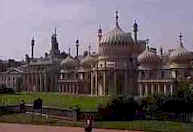 Brighton
is just 49 minutes train ride from central London and 25 minutes from London Gatwick
Airport, there are entertainments of all kind. It is a curious mixture of the brash
vulgarity of seaside piers, winkles, candy floss, furtive, adulterous weekends, and
Regency elegance. Brighton
is just 49 minutes train ride from central London and 25 minutes from London Gatwick
Airport, there are entertainments of all kind. It is a curious mixture of the brash
vulgarity of seaside piers, winkles, candy floss, furtive, adulterous weekends, and
Regency elegance.Until the middle of the 18th century, it was a small fishing village
called Brighthelmstone. In 1750, Dr Richard Russell published a Latin treatise extolling
the virtues of sea water for drinking and bathing. And Brighton's popularity began.
 Suddenly it became fashinable to 'take
the water', and royalty, literati,and the upper classes were pushed down the beach in
bathing machines to plunge modestly into the sea. Suddenly it became fashinable to 'take
the water', and royalty, literati,and the upper classes were pushed down the beach in
bathing machines to plunge modestly into the sea.
The growth of Brighton was encouraged by the arrival of the railway, which brought
increasing numbers of day-trippers to disport themselves on the pebbly beach. Brighton is
also well know as a conference centre, and the major political parties, as well as the
TUC, may hold their conferences there in the autumn.
Brighton's best known landmark has again been
named one of Britain's top tourist attractions. The holiday Which? Guide voted the
Brighton Pavilion one of the seven best heritage sites to visit. This is the second
glowing endorsement of the pavilion in less than a week. The Which? Guide to Tourist
Attractions 2000 voted it the best heritage and history attraction in the UK. The pavilion
got top marks after being judged on value for money, facilities and customer service.
Hot Links
|